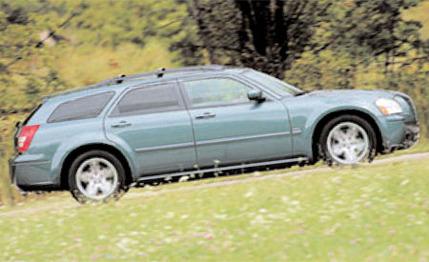
 Short Take Road Test
Short Take Road Test
Before rolling out its new rear-wheel-drive Magnum wagon, Dodge hedged its bets against potential resistance to rear drive by quietly preparing an all-wheel-drive version. Not surprising in light of years spent extolling the virtues of front-wheel-drive traction-not to mention it was Chrysler that hawked "cab forward" styling. Such a reversal of its long-held assertions about all-weather drivability must have made the Dodge boys nervous, so they prepared an all-wheel-drive Magnum in case customers resisted their new rear-drive, full-size lineup.
It turns out that rear-wheel drive and cab-rearward styling took off faster than crack in the '80s. But in places where the winter days are short and snow blowers are as common as lawn mowers, an all-wheel-drive version of the Magnum makes sense if you want to have a chance of putting the 5.7-liter V-8's 390 pound-feet of torque into motion. For those not into freebasing horsepower, the all-wheel-drive system is also available with the 250-hp, 3.5-liter V-6. In the Snowbelt, getting the front tires into the acceleration business means you'll spend less time feathering the throttle and watching the stability-control light blink coquettishly and more time moving.
The system dealing out the power in the Magnum is similar to the latest 4MATIC system available in most Mercedes sedans and wagons. A transfer case near the passenger's footwell next to the transmission sends 38 percent of the power to the front wheels and the remaining 62 percent to the rear. Unlike many active all-wheel-drive systems that can send power back and forth depending on the need, the Dodge doesn't vary the torque split in the driveline. But it does employ traction control at both ends to limit wheelspin.
To distinguish the all-wheel-drive version, there are a couple of AWD badges and another inch in ride height. The lift gives the Magnum an odd stance that shows a lot of fender well. Increasing the ground clearance to 6.6 inches, up from 5.6 inches, gives the Magnum AWD a few advantages-it brings it closer to God and allows it to traverse snowy roads and unmerciful dirt roads with ease. Peer out the windshield and over the long hood, and the view is almost SUV-like, thanks to the higher ride height.
Inside, it's standard Magnum, which unfortunately means a lot of shiny, hard-to-the-touch plastic, but there are also some expensive-looking white-on-black gauges and a clear, strong sound system. Likewise, the shifter and the switchgear have a solid, lasting feel. None of the Magnum's 27 cubic feet (72 with the rear seats folded) of cargo capacity is affected by the addition of the all-wheel-drive hardware, nor is the available 3800-pound towing capacity.
Aside from the ability to accelerate before the salt trucks have made their runs, there are some other dynamic differences between the all-wheel and rear-wheel-drive versions. Move the steering wheel off-center, as you would to enter a corner, and the steering goes from heavy and slow to light and quick and back unexpectedly. The regular Magnum and 300 do not suffer from this steering anomaly. AWD versions have had the quirk, which leads us to suspect the all-wheel-drive system.
What one doesn't notice is the extra 157 pounds the all-wheel drive adds to the Magnum. Strangely enough, acceleration is a tick quicker than in the last rear-drive Magnum we tested ( C/D, January 2005). A sprint to 60 mph takes 5.9 seconds, and the quarter-mile falls in 14.5 seconds at 97 mph. The previous Magnum posted a 6.1-second 0-to-60 and a 14.7-second quarter-mile at 97 mph. The primary difference is that in the rear-drive Hemi-powered Magnum it's easy to break the back tires loose, not so easy to do with all-wheel drive.
Living without slipping tires is certainly a luxury, and not surprisingly, someone has to pay for this. Our test vehicle came in at $36,070 and included a navigation system, heated leather seats, and an upgraded stereo with Sirius satellite radio. That's $2000 more than a comparably equipped rear-drive Magnum. Also taking money out of your wallet, albeit slowly, is the drop in fuel economy of 2 mpg on the highway. (Our two-week average worked out to 13 mpg, but we drive like valets on crystal meth. You'll likely do better.) But if you live in a state where the kids pray for snow days and the terms "wind chill" and "lake-effect snow" are heard more often than Jessica Simpson's name on MTV, the all-wheel-drive Magnum may be worth the extra cash. Otherwise, the rear-drive Magnum with its superior steering should do just fine.